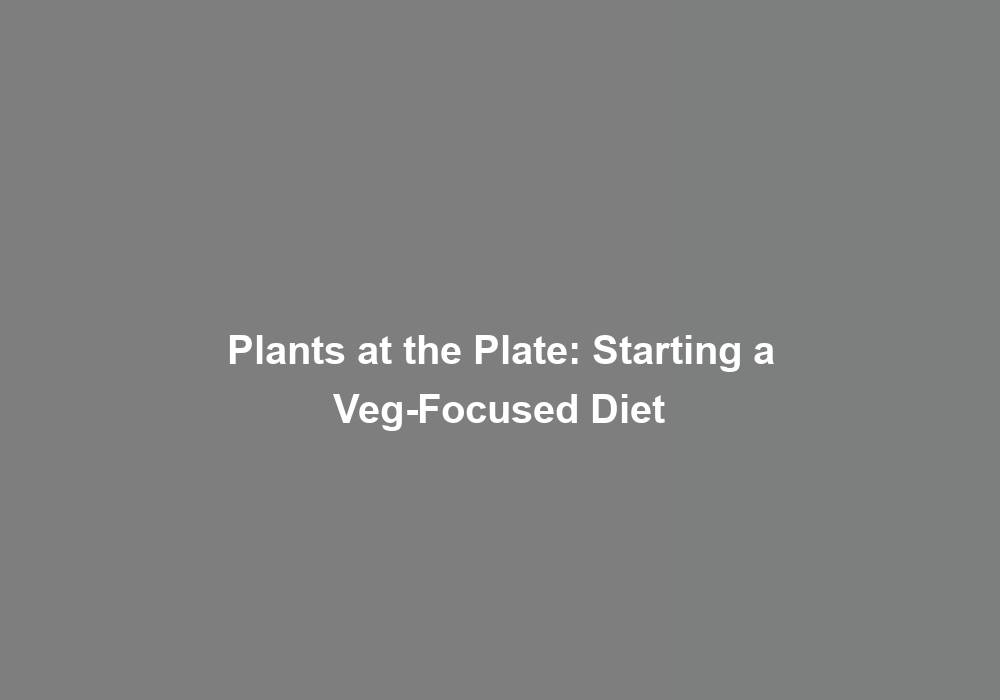Plants at the Plate: Starting a Veg-Focused Diet
So, youG??ve been considering incorporating more vegetables into your diet, but youG??re not quite sure where to start. ItG??s natural to have questions and uncertainties when it comes to making significant changes to your eating habits. Making the shift towards a plant-focused diet can be both exciting and challenging, but the benefits are numerous. Whether youG??re looking to improve your health, reduce your environmental impact, or explore new culinary horizons, embarking on this journey can be incredibly rewarding. LetG??s explore how you can navigate this transition and discover the delights of a veg-focused lifestyle.
Health Benefits of a Veg-Focused Diet
By incorporating a veg-focused diet into your lifestyle, you can experience a wide range of health benefits, including improved heart health, weight management, and a lower risk of chronic diseases. Nutritional benefits of a plant-based diet are well-documented. Fruits and vegetables are rich in essential vitamins, minerals, and antioxidants that are vital for your overall well-being. Consuming a variety of plant-based foods can help lower blood pressure and cholesterol levels, reducing the risk of heart disease and stroke. Additionally, the high fiber content in vegetables can aid in weight management by promoting a feeling of fullness and supporting healthy digestion.
Moreover, the environmental impact of a veg-focused diet is noteworthy. Plant-based diets generally have a lower carbon footprint compared to diets high in animal products. By choosing more plant-based meals, you can contribute to reducing greenhouse gas emissions, preserving water, and protecting natural habitats.
Incorporating more fruits and vegetables into your diet can also lead to a reduced risk of chronic diseases such as type 2 diabetes, certain cancers, and obesity. The abundance of nutrients and phytochemicals in plant-based foods plays a significant role in disease prevention and overall health improvements. Embracing a veg-focused diet can be a powerful step towards improving your health and well-being while positively impacting the environment.
Transitioning to Plant-Based Eating
Are you ready to transition to a plant-based eating plan? ItG??s important to make gradual dietary changes for a smooth transition. You can start by incorporating more plant-based meals into your weekly meal planning and finding delicious meat alternatives to satisfy any cravings.
Dietary Changes for Transition
When transitioning to a plant-based diet, itG??s important to gradually incorporate more vegetables, fruits, whole grains, and legumes into your meals to ensure a balanced and nutritious dietary shift. Food substitutes such as tofu, tempeh, and seitan can be used to replace meat in your favorite dishes, providing a good source of protein. Kitchen equipment like a high-speed blender, food processor, and steamer can make it easier to prepare plant-based meals. Experiment with different cooking methods and flavors to keep your meals interesting and satisfying. Explore new recipes and be open to trying new foods to expand your palate. Making small, sustainable changes over time can help you successfully transition to a plant-based diet while enjoying the process and feeling nourished.
Plant-Based Meal Planning
Considering a plant-based diet? Planning your meals is crucial for a smooth transition to plant-based eating. To help you get started, here are some tips to make your meal planning easier:
- Budget-friendly meal ideas: Look for affordable plant-based protein sources like lentils, beans, and tofu. Incorporate seasonal fruits and vegetables to save money and enjoy fresh produce.
- Quick and easy recipes: Explore simple recipes that require minimal preparation time. One-pot meals, stir-fries, and salads can be nutritious and convenient options for busy days.
- Meal prepping: Spend some time on the weekend prepping ingredients or cooking meals in advance. This can save time during the week and ensure that you have healthy plant-based options readily available.
- Variety and balance: Aim for a diverse range of plant-based foods to ensure youG??re getting a wide array of nutrients. Incorporating different colors, textures, and flavors into your meals can keep things interesting and satisfying.
Overcoming Meat Cravings
To transition to a plant-based diet and overcome meat cravings, itG??s important to focus on incorporating flavorful and satisfying plant-based alternatives into your meals. Coping strategies for overcoming meat cravings include gradually reducing meat intake while exploring new and exciting plant-based recipes. Experiment with a variety of flavorful substitutes such as marinated tofu, tempeh, seitan, or jackfruit as alternatives to meat in your favorite dishes. Additionally, utilizing umami-rich ingredients like mushrooms, nutritional yeast, and miso can help satisfy the savory flavor profile often associated with meat. Incorporating plenty of herbs, spices, and aromatic vegetables like garlic and onions can also enhance the overall flavor and satisfaction of plant-based meals. By gradually introducing these flavorful substitutes and coping strategies, you can successfully transition to a more veg-focused diet and overcome meat cravings.
Essential Nutrients for Vegans and Vegetarians
Maintaining a balanced and nutrient-rich diet is crucial for vegans and vegetarians to ensure they meet their specific dietary needs. While itG??s true that some essential nutrients are more readily available in animal products, there are several plant-based sources that can provide the necessary nutrients for a healthy lifestyle. HereG??s what you need to know:
-
Protein Sources: Contrary to popular belief, there are plenty of plant-based sources of protein. Foods like lentils, chickpeas, quinoa, tofu, tempeh, and edamame are excellent sources of protein. Nuts and seeds such as almonds, chia seeds, and hemp seeds also contribute to protein intake. Incorporating a variety of these foods into your daily meals can ensure youG??re meeting your protein needs.
-
Iron Absorption: Plant-based sources of iron are abundant, but the type of iron found in plants (non-heme iron) is not as readily absorbed by the body as heme iron found in animal products. To enhance iron absorption, consume iron-rich foods alongside those high in vitamin C, such as citrus fruits, bell peppers, and broccoli. Additionally, cooking food in cast-iron cookware can increase its iron content.
-
Calcium Intake: Dairy is a major source of calcium in many diets, but for vegans and some vegetarians, alternatives like fortified plant milks, tofu, tempeh, and dark leafy greens such as kale and collard greens can help meet calcium needs.
-
Vitamin B12 Supplementation: Vitamin B12 is primarily found in animal products, so itG??s important for vegans to obtain it through fortified foods or supplements to prevent deficiency.
Tips for Meal Planning and Grocery Shopping
When planning your meals and grocery shopping as a vegan or vegetarian, it is essential to prioritize a diverse range of nutrient-rich plant-based foods. To ensure a balanced and satisfying diet, incorporating budget-friendly meal ideas and grocery shopping hacks can be immensely helpful. When considering meal planning, focus on quick and easy meal prep options to streamline your cooking process. Batch cooking grains, legumes, and roasted vegetables at the beginning of the week can save time and make meal assembly a breeze. Additionally, incorporating versatile ingredients such as tofu, tempeh, lentils, and chickpeas can provide ample vegan protein sources to support your dietary needs.
When grocery shopping, itG??s beneficial to have a clear list of essentials to avoid unnecessary purchases. Opt for cost-effective staples like dried beans, rice, and in-season fruits and vegetables. Utilize frozen produce when fresh options are expensive or not readily available. This not only helps with budgeting but also ensures you always have an abundance of fruits and vegetables on hand. Look for sales and consider buying in bulk for items you frequently use. DonG??t forget to explore international or ethnic grocery stores for affordable spices, grains, and specialty ingredients.
Exploring Flavorful Plant-Based Recipes
Incorporate a variety of aromatic herbs and spices to enhance the depth of flavor in your plant-based dishes. By experimenting with different flavorful spices, you can elevate the taste profile of your meals and make your transition to a veg-focused diet more enjoyable. Here are some tips to help you explore flavorful plant-based recipes:
-
Experiment with Flavorful Spices: Embrace the world of spices such as cumin, smoked paprika, turmeric, and coriander to add layers of complexity to your dishes. These spices not only bring unique flavors but also offer various health benefits.
-
Utilize Fresh Herbs: Elevate your dishes with the vibrant flavors of fresh herbs like basil, cilantro, mint, and parsley. These herbs not only add freshness but also contribute to the overall sensory experience of your meals.
-
Get Creative with Substitutions: Explore creative substitutions for traditional ingredients. For instance, use nutritional yeast for a cheesy flavor, or swap out regular salt for black salt (kala namak) to add an eggy taste to your tofu scrambles.
-
Balance Flavors: Pay attention to balancing flavors such as sweetness, saltiness, sourness, and spiciness. Experiment with different combinations to create well-rounded and satisfying plant-based dishes.
Navigating Social Situations and Dining Out
When dining out with friends, itG??s important to communicate your dietary preferences in advance and suggest restaurants with veg-friendly options. Look for menu items that are naturally plant-based or can be easily modified, such as salads, veggie stir-fries, or grain bowls. You can also consider speaking with the restaurant staff to ensure that your meal aligns with your dietary needs.
Dining With Friends
To navigate social situations and dining out while following a veg-focused diet, itG??s essential to communicate your dietary preferences and explore menu options in advance to ensure a satisfying and enjoyable experience for everyone involved. When dining out or attending social events, consider the following tips:
-
Communicate with the Host: When navigating invitations, kindly communicate your dietary preferences to the host and offer to bring a dish to share that aligns with your veg-focused diet.
-
Explore Menu Options: Before dining out, review the menu online or call the restaurant to inquire about veg-friendly options, ensuring a stress-free dining experience.
-
Suggest Veg-Friendly Restaurants: When planning gatherings, suggest restaurants with diverse menu options to accommodate various dietary preferences.
-
Promote Inclusivity: Encourage open communication and consideration for all dietary preferences when hosting gatherings, fostering a sense of belonging for all attendees.
Restaurant Menu Options
Exploring restaurant menu options in advance can help ensure an enjoyable dining experience while adhering to a veg-focused diet and navigating social situations. Many restaurants now offer menu adaptations to cater to various dietary preferences, including vegan-friendly options. When planning to dine out, you can research local restaurants known for their accommodating menus. Look for establishments that clearly label vegan options or are willing to make adaptations upon request. Some restaurants may even have a separate vegan menu available upon inquiry. When dining with friends or family, suggest these vegan-friendly establishments to ensure that everyone can find something to enjoy. By familiarizing yourself with restaurant menu options beforehand, you can confidently navigate social situations and make informed choices that align with your veg-focused lifestyle.
Conclusion
In conclusion, making the transition to a veg-focused diet can have numerous health benefits and offer a wide variety of flavorful and nutritious meal options. By prioritizing essential nutrients and exploring new recipes, you can create a balanced and satisfying plant-based diet. So, why not take the leap and start incorporating more vegetables and plant-based foods into your meals? You may be surprised at how delicious and fulfilling this new way of eating can be.







